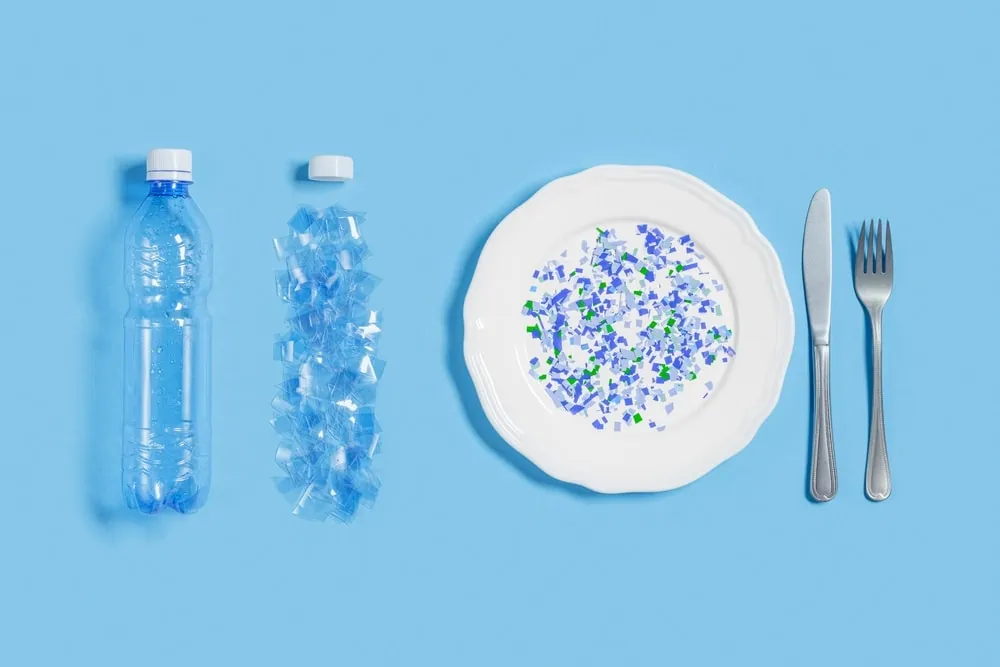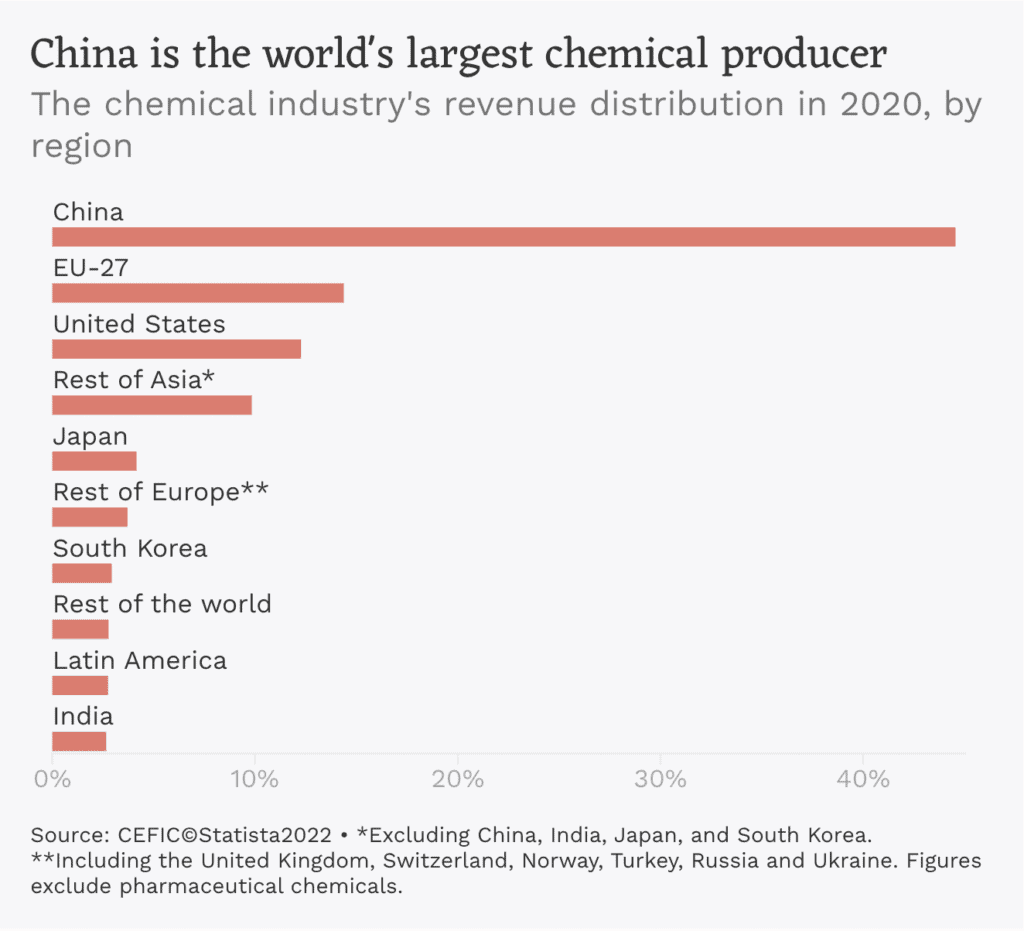Hopes are high that an action plan will help control chemicals with ongoing harmful effects, though experts note a lack of supporting legislation, writes Lin Zi from China Dialogue
In 2014, China declared a “war on pollution”. Since then, air quality has improved significantly, with nationwide levels of PM2.5 – harmful fine particles less than 2.5 micrometres wide – dropping by 58%. With the first campaign in that war won, China is now setting its sights on less visible pollutants.
The term “new pollutants” (新污染物) has come up frequently. It appeared in the 14th Five Year Plan, during the crucial Two Sessions political and legislative meetings, and in the outline of the Vision 2035 plan for “socialist modernisation”. It refers to hidden pollutants that lurk in the environment, cause damage in the long term – and are much harder to tackle.
The main source of these pollutants is the production and use of harmful and toxic chemicals. In May, the State Council published an action plan on new pollutants, kicking off a process of identifying such substances and assessing the harm they cause. Restrictions and bans were also put in place for a first batch of chemicals. There are hopes this will plug existing gaps in China’s chemicals regime.
Exposing the new pollutants
In actual fact, many “new” pollutants are nothing new. At a press conference in March, a Ministry of Ecology and Environment spokesperson said such pollutants are being described this way because they are less familiar to the public than conventional pollutants like sulphur dioxide and nitrogen oxides; and because as understanding grows of the damage chemicals cause, and methods for detecting them improve, new harms and pollutants are being identified.
New pollutants are chemical in nature. In the US, the Environmental Protection Agency refers to them as “chemicals of emerging concern”. These substances may be more common than you think, occurring in everyday medicines, cosmetics, insecticides and detergents, as well as commonly used industrial products. Think of the formaldehyde in shampoo, plastic microbeads in toothpaste, plasticisers in food packaging, fire retardants in televisions, and even antibacterials in soap. Their use and release into the environment can cause long-term negative effects and health issues, even in small quantities. These include endocrine disorders in both aquatic life and humans, and antibiotic resistance.
Both government and the public have overlooked these new pollutants — He Linghui, senior project chief with Shenzhen Zero Waste
China’s standards for environmental quality and pollutant emissions mainly focus on more conventional pollutants, as do its lists of managed chemicals. Most feature on one of two lists: for air pollutants and for water pollutants. Once listed, chemicals can be controlled under laws on air and water pollution.
“Most new pollutants – such as antibiotics, microplastics and perfluorinated compounds – aren’t covered by environmental standards for air, water and soil, and mostly go unmonitored,” said He Linghui, senior project chief with Shenzhen Zero Waste, adding that “both government and the public have overlooked these new pollutants”.
Fixing holes
The State Council’s new action plan includes identifying and assessing the environmental risks associated with these chemicals and deciding which ones most need to be controlled. Whole-lifecycle restrictions will be placed on new pollutants, including bans on their production and use, reduction of emissions during use, and end-of-pipe solutions (pollution control that concentrates on filtration prior to discharge into the environment rather than preventing the pollutant occurring in the first place).
According to the action plan, the identification process for high-concern and high-production volume chemicals will be complete by 2025, as will a first batch of environmental risk assessments.
“The action plan reflects a prevention-first approach to environmental risks,” said Liu Jianguo, an associate professor at Peking University’s College of Environmental Sciences and Engineering. “It is an important step in plugging gaps in China’s management of hazardous chemicals.”
That management has long been focused on industrial safety and prevention of accidents, leading to significant blind spots. The “imminent” risks of inflammable, explosive and highly toxic chemicals get plenty of attention, but hidden and long-term environmental harms are overlooked.
“China has a grasp on the risks associated with the 2,800 substances on the lists of hazardous chemicals. But there’s a lack of information and understanding of the potential environmental and health harms associated with tens of thousands of other chemicals on the market,” Liu said.

Many manufacturers use chemicals in their fabrics, not all of them with negligible health impacts
A first list of “new pollutants for priority control” will be published this year, the plan says. Substances on those lists will either be banned or subjected to usage and emissions restrictions. Meanwhile, regulators are revising guidelines on industrial restructuring in order to gradually phase out some pesticides, veterinary drugs, cosmetics and industrial chemicals.
The action plan also calls for stronger environmental impact assessments, with tough requirements for projects involving new pollutants. The list of new pollutants for priority control will be updated as more chemicals are assessed.
An earlier consultation draft of the plan included a list of 28 new pollutants for priority control. These were mainly persistent organic pollutants, endocrine-disrupting chemicals and antibiotics already restricted by international treaties.
Tougher management of consumer products
China is the world’s biggest producer and consumer of chemicals. Globally, the chemicals industry is worth around US$4 trillion a year, with China’s industry accounting for 45% of that figure. In 2020, chemicals worth US$1.77 trillion were consumed in China. These essential raw materials are widely used in making medicines, pesticides, fertilisers, plastics, textiles, building supplies, laundry detergents and cosmetics.
Information on excessive levels of chemicals in consumer products has long been buried in reports on “below-standard products” issued by regulators. Shenzhen Zero Waste collected info on 1,300 China-sourced products listed on the EU’s Rapid Alert System for Non-food Consumer Products warning system between 2019 and 2021, along with 1,700 reports of products failing sample testing published by China’s own regulators. Problem products included clothes, appliances, stationery, toys, home textiles, handbags and shoes. The organisation then looked at cases where levels of chemicals were found to be in breach of standards, finding over 100 different chemicals at fault, with phthalates the most common offender.
Phthalates – a group of chemicals often used to make plastic more flexible and therefore durable – disrupt the endocrine system, harm fertility, and can be absorbed through skin contact or respiration. They are particularly harmful for pregnant women and young children.
This is a significant step forward for China’s chemical regime
— Liu Jianguo, associate professor at Peking University
“The main problem is a lack of controls during manufacturing,” said He Linghui. “But we also note that the number of consumer product chemicals subject to controls in China is limited, with most persistent organic pollutants and endocrine-disrupting chemicals not listed, or only listed in certain products.”
She explained that persistent organic pollutants are not covered by any consumer product standard. These include perfluorooctanoic acid (PFOA) – which is used to coat non-stick cookware and fast food packaging – and short-chain chlorinated paraffins (SCCPs) – the uses of which include fire retardants for textiles. Bisphenol A, an endocrine-disrupting chemical, is banned in baby bottles, but permitted in certain quantities in food packaging.
The action plan aims to bolster management of chemicals in consumer products, calling for limits and bans on new pollutants for priority control to be included in environmental labelling systems, standards and certifications, and requiring those substances be listed in labelling for key consumer goods. It also calls for restrictions on new pollutants to be added to the compulsory national standards for products such as toys and school supplies – and strictly enforced.
“The health or environmental damage caused by a chemical isn’t decided by its properties alone – the dose to which people or organisms are exposed is the deciding factor,” Liu Jianguo noted. “In the past, national standards for chemicals in consumer products were limited. Those chemicals, under the heading of ‘new pollutants’, will now be covered by product standards, to some degree bringing China in line with international practice. This is a significant step forward for China’s chemical regime.”
Controlling drinking water risks
The Yangtze and Yellow River basins are major sources of drinking water for China, but their banks are home to many chemical plants. The action plan will see pilot projects launched to clean up new pollutants on the rivers and other important sources of drinking water, and in certain industries. The list of new pollutants for priority control issued with the earlier consultation draft included antibiotics, perfluorooctanoic acid (PFOA) and perfluorooctanesulfonic acid (PFOS) – all of which have been the cause of recent concern over polluted drinking water.
In 2020, the news magazine Outlook Weekly published a report on antibiotic pollution of the Yangtze basin, putting average levels at 156 nanograms per litre of water – higher than levels found in the US and EU.
Antibiotics in the environment lead to antibiotic-resistant bacteria and genes, which are a threat to human health and the environment. Outlook’s report was included in a submission to the Two Sessions by the China Association for Promoting Democracy, which in turn was noted by the government.
In 2021, a team from Tsinghua University published a study in Environmental Sciences Europe, showing that drinking water in 66 Chinese cities and regions had high levels of perfluorinated and polyfluorinated alkyl substances, peaking at 502.9 nanograms per litre in one city. Over 40% of the cities studied had levels over a recommended limit published by the US state of California in 2019, of 5.1 nanograms per litre for PFOA and 6.5 nanograms for PFOS.
Animal studies have found exposure to perfluorinated compounds to be linked to a range of negative outcomes, including higher rates of testicular and kidney cancer, falls in fertility, and immune system and thyroid issues.
In March this year, China revised its safety standards for drinking water, with a wider range of pollutants included in compulsory restrictions and water quality values. New pollutants such as perfluorinated compounds are now included as a measure of water quality, but not antibiotics.
According to the action plan, the first steps towards a system for monitoring new pollutants in the environment will be in place by the end of 2025. The Ministry of Ecology and Environment’s National Environmental Analysis and Monitoring Centre says methodologies for monitoring antibiotics, perfluorinated compounds, volatile organic compounds and persistent organic pollutants have already been developed. The ministry is also to promote sharing of new-pollutant monitoring data gathered by research bodies.
We need to avoid a vicious circle where today’s replacements become tomorrow’s pollutants
– Zheng Minghui, State Key Laboratory of Environmental Chemistry and Ecotoxicity
While commenting on clean-up and substitution of perfluorinated compounds in an interview with China Environmental News, Zheng Minghui, vice-chair of the standing committee of the State Key Laboratory of Environmental Chemistry and Ecotoxicity, said that China is only just starting research into replacements for high-risk chemicals. This process, he said, will focus on identifying new pollutants and their toxic effects, possible replacements, and providing support for clean-up operations. “We need to avoid a vicious circle where today’s replacements become tomorrow’s pollutants,” added Zheng, who is also a researcher at the Chinese Academy of Sciences’ Research Centre for Eco-Environmental Sciences.
Also, key manufacturers and industrial zones in the petrochemical, paints, textiles, rubber, pesticide and pharmaceutical sectors will be chosen for pilot clean-up projects, with replacement and emissions reduction measures to be taken. This will reduce these forms of pollution at source, while polluted water, soil and sludge linked to these operations will be treated.
The next step: legislation
As tackling new pollutants will cover a range of sectors, cross-departmental cooperation and a comprehensive approach will be needed. The action plan was published by the State Council, with the Ministry of Ecology and Environment (MEE) the lead department in charge of coordinating across other bodies: the National Development and Reform Commission, the Ministry of Agriculture and Rural Affairs, and market and pharmaceutical regulators, among others.
“This means State Council-level coordination on implementing the action plan, which will help establish a cross-departmental mechanism for managing chemicals. That’s a key condition for ongoing reform and improvements,” said Liu Jianguo.
While the action plan includes targets and timetables, experts say there’s a lack of legislation to support its implementation.
Currently, China has no law specifically on management of chemicals in the environment. Wang Jinnan, an academic in the Chinese Academy of Engineering and head of the MEE’s Chinese Academy of Environmental Planning, has written that there is no legislative backing for the reporting and risk-reduction responsibilities the action plan delegates to businesses. The same is true for bans and restrictions on the use of toxic and harmful chemicals.
A Hazardous Chemicals Safety Law, China’s first such legislation, is currently in a consultation phase. Industry insiders say it may simply be an upgrading of an existing set of regulations, which may be insufficient in addressing the problem of chemicals with long-term harmful effects.
China’s management of chemicals has always been focused on preventing industrial accidents, with the Ministry of Emergency Management (MEM), formerly the State Administration of Work Safety, in charge. It was the MEM which drafted the proposed Hazardous Chemicals Safety Law.
In China, the term “hazardous chemicals” is generally taken to refer to those which are inflammable or explosive, or do immediate harm to health and the environment. The Hazardous Chemicals Safety Law may therefore focus on the prevention of industrial accidents, but overlook the long-term harm chemicals can cause in ordinary production and use.
However, the action plan does call for regulations to manage “toxic and harmful” chemicals. Insiders say that would fill out the chemicals regime and allow for better management of environmental risks, while granting more powers to the MEM.
“As a developing nation and a major producer and consumer of chemicals, China is facing far more complex economic, technical and management challenges than other countries,” said Liu Jianguo. “Tackling new pollutants will be a case of slow and steady progress. The action plan is appropriate for China and reflects how our management of chemicals is shifting from a focus on industrial safety to managing environmental and health risks.”
This article was originally published on China Dialogue under the Creative Commons BY NC ND licence.





